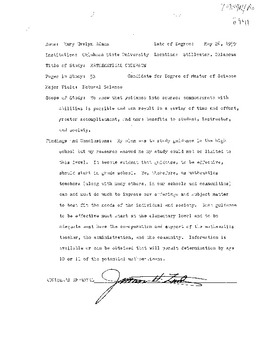| dc.contributor.advisor | Zant, James H. | |
| dc.contributor.author | Adams, Mary Evelyn | |
| dc.date.accessioned | 2016-03-03T20:09:06Z | |
| dc.date.available | 2016-03-03T20:09:06Z | |
| dc.date.issued | 1959-05 | |
| dc.identifier.uri | https://hdl.handle.net/11244/32162 | |
| dc.description.abstract | Scope of Study: To show that guidance into courses commeasurate with abilities is possible and can result in a saving of time and effort, greater accomplishment, and more benefits to student, instructor, and society. | |
| dc.description.abstract | Findings and Conclusions: My plan was to study guidance in the high school but my research showed me my study could not be limited to this level. It became evident that guidance, to be effective, should start in grade school. We, therefore, as mathematics teachers (along with many others, in our schools and communities) can and must do much to improve our offerings and subject matter to best fit the needs of the individual and society. Such guidance to be effective must start at the elementary level and to be adequate must have the co-operation and support of the mathematics teacher, the administration, and the community. Information is available or can be obtained that will permit determination by age 10 or 11 of the potential mathematicians. | |
| dc.format | application/pdf | |
| dc.language | en_US | |
| dc.rights | Copyright is held by the author who has granted the Oklahoma State University Library the non-exclusive right to share this material in its institutional repository. Contact Digital Library Services at lib-dls@okstate.edu or 405-744-9161 for the permission policy on the use, reproduction or distribution of this material. | |
| dc.title | Mathematical guidance | |
| osu.filename | Thesis-1959R-A215m.pdf | |
| osu.accesstype | Open Access | |
| dc.type.genre | Master's Report | |
| dc.type.material | Text | |
| thesis.degree.discipline | Natural Science | |
| thesis.degree.grantor | Oklahoma State University | |
